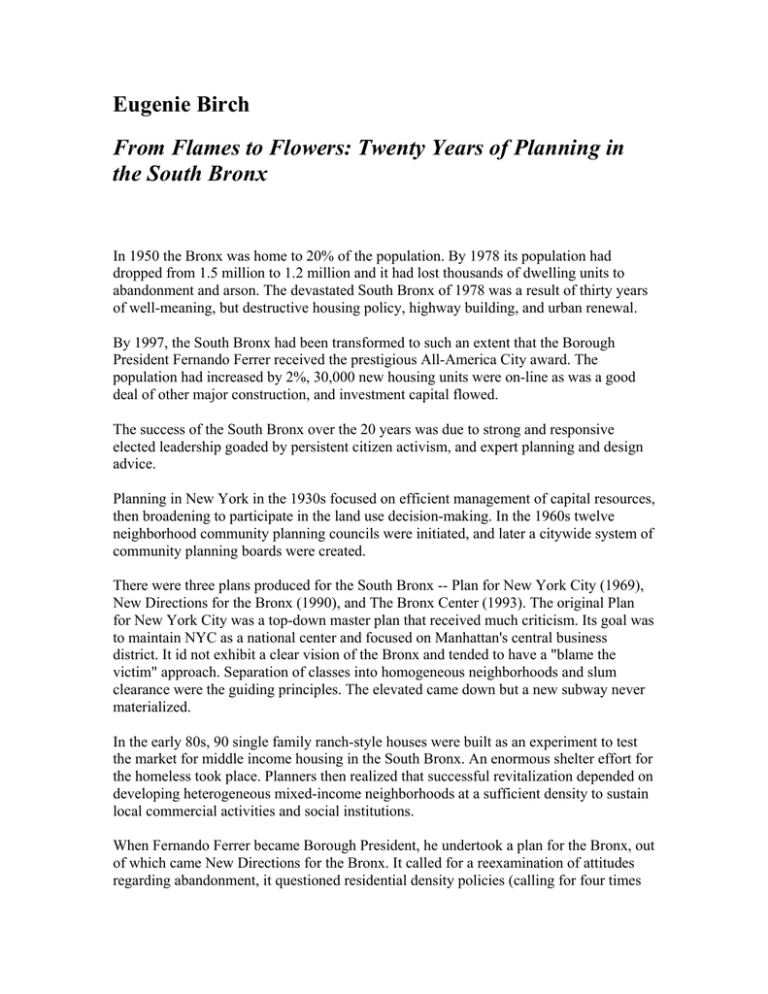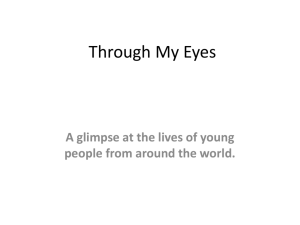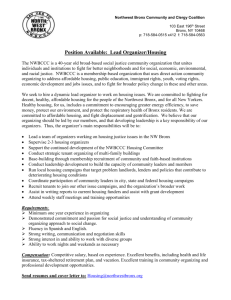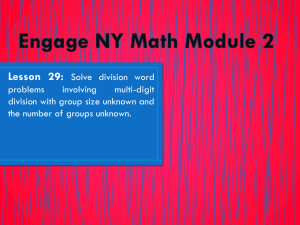Eugenie Birch From Flames to Flowers: Twenty Years of Planning in
advertisement

Eugenie Birch From Flames to Flowers: Twenty Years of Planning in the South Bronx In 1950 the Bronx was home to 20% of the population. By 1978 its population had dropped from 1.5 million to 1.2 million and it had lost thousands of dwelling units to abandonment and arson. The devastated South Bronx of 1978 was a result of thirty years of well-meaning, but destructive housing policy, highway building, and urban renewal. By 1997, the South Bronx had been transformed to such an extent that the Borough President Fernando Ferrer received the prestigious All-America City award. The population had increased by 2%, 30,000 new housing units were on-line as was a good deal of other major construction, and investment capital flowed. The success of the South Bronx over the 20 years was due to strong and responsive elected leadership goaded by persistent citizen activism, and expert planning and design advice. Planning in New York in the 1930s focused on efficient management of capital resources, then broadening to participate in the land use decision-making. In the 1960s twelve neighborhood community planning councils were initiated, and later a citywide system of community planning boards were created. There were three plans produced for the South Bronx -- Plan for New York City (1969), New Directions for the Bronx (1990), and The Bronx Center (1993). The original Plan for New York City was a top-down master plan that received much criticism. Its goal was to maintain NYC as a national center and focused on Manhattan's central business district. It id not exhibit a clear vision of the Bronx and tended to have a "blame the victim" approach. Separation of classes into homogeneous neighborhoods and slum clearance were the guiding principles. The elevated came down but a new subway never materialized. In the early 80s, 90 single family ranch-style houses were built as an experiment to test the market for middle income housing in the South Bronx. An enormous shelter effort for the homeless took place. Planners then realized that successful revitalization depended on developing heterogeneous mixed-income neighborhoods at a sufficient density to sustain local commercial activities and social institutions. When Fernando Ferrer became Borough President, he undertook a plan for the Bronx, out of which came New Directions for the Bronx. It called for a reexamination of attitudes regarding abandonment, it questioned residential density policies (calling for four times the existing practices), recommended increased home ownership, and it called for the development of a comprehensive plan for the Bronx Center, a 300-block area encompassing the borough's civic and commercial heart. It also insisted on including meaningful citizen participation in the planning process. In 1993, the document, The Bronx Center, was published which addressed economic development, housing, open space and urban design, health and human services, education, culture and transportation, with the Bronx Center acting as an economic engine for the borough. While the borough president was developing his vision, The city's Planning Department, Community Board Three, the city's Department of Sanitation, the Human Resources Administration, Department of General Services, the Department of Transportation, and various non-profit housing groups were all preparing plans and projects in the South Bronx. Melrose Commons and Site 404 illustrate the nature of the different visions. The population of Melrose Commons had dropped from 21,000 in 1970 to 3,000 in 1980. The plan was to build 2,600 dwellings arranged in two-, four-, and six-story buildings. It required the relocation of 260 households and 88 businesses and community facilities, but the Bronx Borough president and steering committee deemed the displacement unfortunate but necessary. But the residents protested. Faced with angry residents, the Borough president and committee retracted their endorsement. A new proposal was presented, with the participation of residents, agencies, architects, and volunteer planners. Still another alternative vision for development emerged from the developers an the Department of Housing Preservation and Development. A bitter debate ensued. Site 404 was a 4.4 acre site near mass transit and the commercial center. A group, South Bronx Churches, proposed 80 low density dwellings. Securing the site because a holy cause. The HPD sent out a request for proposals and awarded the site to a local developer. The SBC was enraged, but the city held fast and the first residents moved in. Questions and Comments Q: I have a question about Melrose Common. I see that a lot of the names are Spanish names, and in terms of image, I wonder if this was the right move in terms of attracting people to the area, because as an outsider, I might think that its a Latin American enclave. A: Well, 22% of the population is Hispanic and the group feels strongly about maintaining their culture, but you're right -- though they want to attract different groups, the message that it gives is that the place is not multi-ethnic. Q: I'm interested in the role of the documents, as a paper trail. Did they reconcile images? A: The 1969 plan was immediately out-dated. The Ferrer documents circulated and they articulated images, but it's not pictures. These documents are policy. Q: But do people internalize the policy? Q: I was thinking about the physical manifestation -- to what extend are there formal planning processes able to articulate that common vision? A: It's a highly politicized process. If the people who are there say that they want it change, it will be changed. Q: Could you differentiate between the term vision and the term image? A: I have used them interchangeably. Q: You put forth how people use narrative to create an effective image. Did they not use visual images in order to further their own agenda or vision? Or was it less diabolical than that? A: ... It was more a case of them being so concerned about getting the wording right. Q: As a community organizer in the North Bronx, I would categorize it as a conflict of image, but whose image. Ferrer plays a role of this and he reversed his position a number of times. A: He is a politician. Q: I'm still not clear about the density question. A: They wanted action on the streets -- people. And actin was associated with the old densities. Q: Yes, but that was pre-automobile. What does it take to support those number now? David Laws, real-time rapporteur I will comment on the history presented by Professor Birch from the perspective of negotiation and deliberative democracy. In the planning efforts in the South Bronx, the planners and politicians maintained a monopoly on voice -- a monopoly that extended to the generation of images. It is not too much of an over generalization to characterize the developments in the history of Bronx as an understandable outcome when exit is the most viable option and opportunities for voice are limited and caricatured. Some of the changes that took place in New York were explicitly intended to extend opportunities for voice to citizens by creating opportunities for public involvement. Yet the outcome of these efforts should make us wonder whether it is opportunities for voice, as such, that is the issue. At the same time these reforms created opportunities for voice they also extended the strategic view of planning and decision-making that characterized city politics in New York during this period.. These developments in the way planning was done and development decisions were made both demonstrated and confirmed an expectation that the only viable image of city planning and politics was a strategic contest for resources and votes. Given this background, we should perhaps expect, rather than be surprised by, the kind of dynamics and interplay that characterize the stories about Melrose Commons and Site 404. To illustrate this more specifically I would like to give a reading of these two cases drawing on a view of the political interaction as a conversation. The first I'd like to refer to as exclusion calls attention to the force that plans, proposals, and images exert through the position they occupy within a conversation. The most dramatic instance of this is when a proposal so dominates the conversation that other plans, designs, or images are effectively excluded. Even a reasonable view can become unreasonable when it is presented or defended in this way. Exclusion is common when the conversation about what to do is simultaneous with the debate over resources. The second concept is ambiguity. This is the well known insight that our concepts, plans, and images often permit multiple interpretations and are likely to be understood in different ways by individuals who have diverse backgrounds and subjective orientations. A big part of conversation, in this view, is the continual discovery and resolution of such ambiguities. Finally, there is the notion of divided, or differentiated, identity. This is simply the insight that at the level of self, organization, or community, identity is often characterized by the effort to manage persistent tensions and contradictions rather than by an ability to express values in a consistent and stable ordering. In the language of this colloquium, we should look at how political and administrative process structures opportunities for voice, which includes authoring images. We can see the political process as, at least potentially, a conversation about diverse aims and images. We can understand that part of the challenge this sets is how to create a terrain -- a vocabulary and set of norms and practices -- that will enable us to carry on this conversation and to continue to have "meaningful disagreements." Each move, each actor makes, from starting to talk to generating plans, designs, and other images. Structures, not only the substantive content, but also the norms and expectations that shape behavior in any conversation. We might fruitfully see this challenge, in terms Don Schon might have used, as the challenge of creating a "community of reliable inquiry" that can engage these questions meaningfully and productively.


